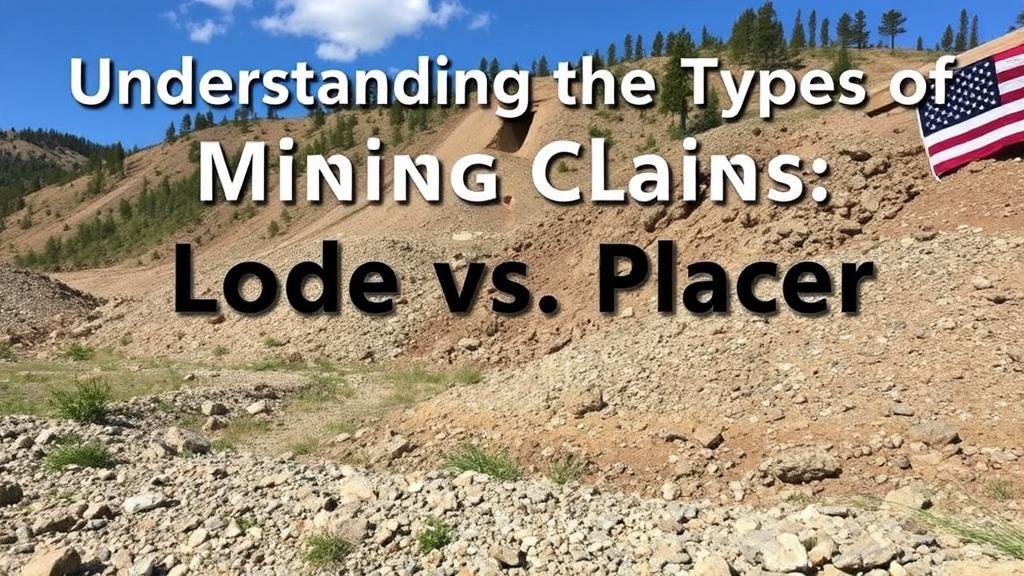Understanding the Types of Mining Claims: Lode vs. Placer
Understanding the Types of Mining Claims: Lode vs. Placer
Mining claims are essential legal documents that vest certain rights to individuals or companies to extract valuable minerals from the Earth. Within the realm of mining claims, two primary types are recognized: lode and placer claims. Each type has distinct characteristics, regulations, and applications in mineral extraction. This article aims to elucidate the differences between lode and placer mining claims, provide concrete examples, and demonstrate their relevance in the broader context of the mining industry.
What is a Lode Claim?
A lode claim is a type of mining claim that pertains to minerals found in a solid, concentrated manner, often embedded in rock formations. These claims are typically associated with hard rock mining and are focused on the extraction of valuable minerals such as gold, silver, lead, and copper. In essence, lode claims involve the search for ore that is contained within the bedrock.
For example, the famous Comstock Lode in Nevada, discovered in 1859, yielded significant amounts of silver and attracted numerous miners to the area. The discovery led to the establishment of several mining towns, showcasing how lode claims can catalyze economic growth and population influx.
Regulations Surrounding Lode Claims
Lode claims are generally governed by federal regulations under the General Mining Law of 1872 in the United States. To establish a lode claim, certain requirements must be met:
- The claimant must locate the mineral deposit.
- A notice of location must be filed with the appropriate governing body.
- A map depicting the claim boundaries must also be submitted.
- The claimant must perform a minimum amount of work (often referred to as assessment work) to maintain the claim.
Such requirements ensure that lode claims are legitimate and that claimants actively pursue the extraction process.
What is a Placer Claim?
In contrast, a placer claim pertains to minerals that have been eroded from their original lode deposits and are found in a loose, unconsolidated form. e claims are typically associated with alluvial deposits, which are accumulations of minerals transported by water and deposited in riverbeds, streambeds, and other similar environments. Placer claims are most commonly linked to gold, gravel, and gemstones.
An illustrative example of placer mining is the California Gold Rush of 1849, where countless miners panned for gold in rivers and streams. This historical event underscores the significance of placer claims in mineral extraction and the potential for individual prospectors to uncover lucrative deposits.
Regulations Surrounding Placer Claims
Similar to lode claims, placer claims are regulated under the General Mining Law of 1872 and require adherence to specific rules:
- The claim must be located near a water source.
- A notice of location and description must be filed with relevant authorities.
- Proof of placer mining activities, such as excavation or processing, is required to maintain the claim.
The requirements for placer claims ensure that miners are engaging in responsible mining practices while capitalizing on the erosion of minerals in natural settings.
Key Differences Between Lode and Placer Claims
The primary differences between lode and placer claims can be summarized as follows:
- Type of Material: Lode claims focus on minerals embedded in solid rock, whereas placer claims are for minerals found in loose, unconsolidated material.
- Mining Method: Lode mining typically involves hard rock mining techniques, while placer mining often employs methods like panning, sluicing, or dredging.
- Claim Location: Lode claims are tied to specific rock formations, whereas placer claims are usually associated with waterways and sedimentary environments.
Understanding these differences is crucial for miners when deciding which type of claim to pursue based on their resources, skills, and intended mining methods.
Real-World Applications of Mining Claims
Mining claims serve not only as a source of economic opportunity but also as a distinct legal framework that regulates mineral extraction. For example, in modern mining operations, companies may operate both lode and placer claims simultaneously, allowing them to diversify their mineral extraction activities. Effective planning, including geological surveys and environmental assessments, helps miners optimize their claims and ensure compliance with regulations.
Also, the rise of responsible sourcing practices has prompted miners to embrace environmentally sustainable techniques, particularly in placer mining, which can significantly mitigate ecological impacts. An example of this is the use of environmentally sensitive dredging methods that reduce damage to river ecosystems while maximizing resource recovery.
Conclusion
In summary, the types of mining claims–lode and placer–represent two distinct methods of mineral extraction, each with its own set of regulations and practices. Understanding these differences not only informs potential claimants about their rights and responsibilities but also provides insights into the broader mining industry landscape. As the demand for minerals continues to grow, awareness of the various mining claims will be critical for sustainable and responsible extraction efforts.
By recognizing the characteristics and requirements of lode and placer claims, individuals and companies can make informed decisions that align with their mining aspirations while adhering to legal and environmental standards.



